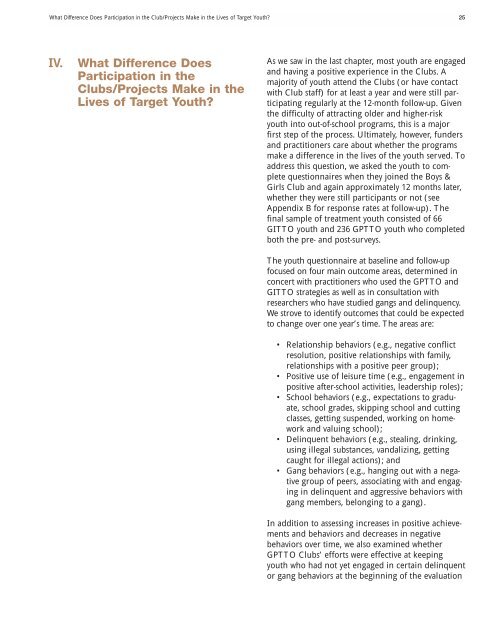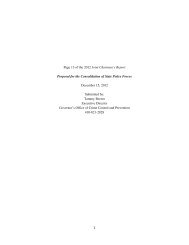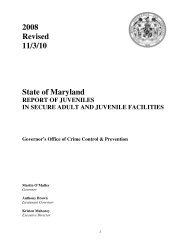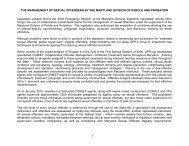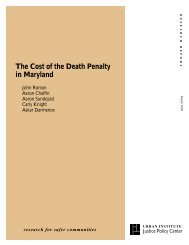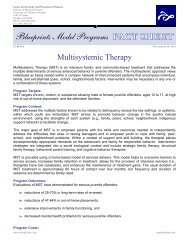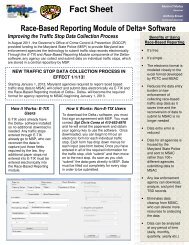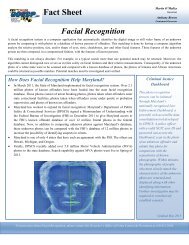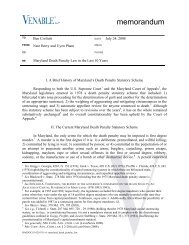Targeted Outreach - Governor's Office of Crime Control & Prevention ...
Targeted Outreach - Governor's Office of Crime Control & Prevention ...
Targeted Outreach - Governor's Office of Crime Control & Prevention ...
You also want an ePaper? Increase the reach of your titles
YUMPU automatically turns print PDFs into web optimized ePapers that Google loves.
What Difference Does Participation in the Club/Projects Make in the Lives <strong>of</strong> Target Youth? 25<br />
IV.<br />
What Difference Does<br />
Participation in the<br />
Clubs/Projects Make in the<br />
Lives <strong>of</strong> Target Youth?<br />
As we saw in the last chapter, most youth are engaged<br />
and having a positive experience in the Clubs. A<br />
majority <strong>of</strong> youth attend the Clubs (or have contact<br />
with Club staff) for at least a year and were still participating<br />
regularly at the 12-month follow-up. Given<br />
the difficulty <strong>of</strong> attracting older and higher-risk<br />
youth into out-<strong>of</strong>-school programs, this is a major<br />
first step <strong>of</strong> the process. Ultimately, however, funders<br />
and practitioners care about whether the programs<br />
make a difference in the lives <strong>of</strong> the youth served. To<br />
address this question, we asked the youth to complete<br />
questionnaires when they joined the Boys &<br />
Girls Club and again approximately 12 months later,<br />
whether they were still participants or not (see<br />
Appendix B for response rates at follow-up). The<br />
final sample <strong>of</strong> treatment youth consisted <strong>of</strong> 66<br />
GITTO youth and 236 GPTTO youth who completed<br />
both the pre- and post-surveys.<br />
The youth questionnaire at baseline and follow-up<br />
focused on four main outcome areas, determined in<br />
concert with practitioners who used the GPTTO and<br />
GITTO strategies as well as in consultation with<br />
researchers who have studied gangs and delinquency.<br />
We strove to identify outcomes that could be expected<br />
to change over one year’s time. The areas are:<br />
• Relationship behaviors (e.g., negative conflict<br />
resolution, positive relationships with family,<br />
relationships with a positive peer group);<br />
• Positive use <strong>of</strong> leisure time (e.g., engagement in<br />
positive after-school activities, leadership roles);<br />
• School behaviors (e.g., expectations to graduate,<br />
school grades, skipping school and cutting<br />
classes, getting suspended, working on homework<br />
and valuing school);<br />
• Delinquent behaviors (e.g., stealing, drinking,<br />
using illegal substances, vandalizing, getting<br />
caught for illegal actions); and<br />
• Gang behaviors (e.g., hanging out with a negative<br />
group <strong>of</strong> peers, associating with and engaging<br />
in delinquent and aggressive behaviors with<br />
gang members, belonging to a gang).<br />
In addition to assessing increases in positive achievements<br />
and behaviors and decreases in negative<br />
behaviors over time, we also examined whether<br />
GPTTO Clubs’ efforts were effective at keeping<br />
youth who had not yet engaged in certain delinquent<br />
or gang behaviors at the beginning <strong>of</strong> the evaluation


